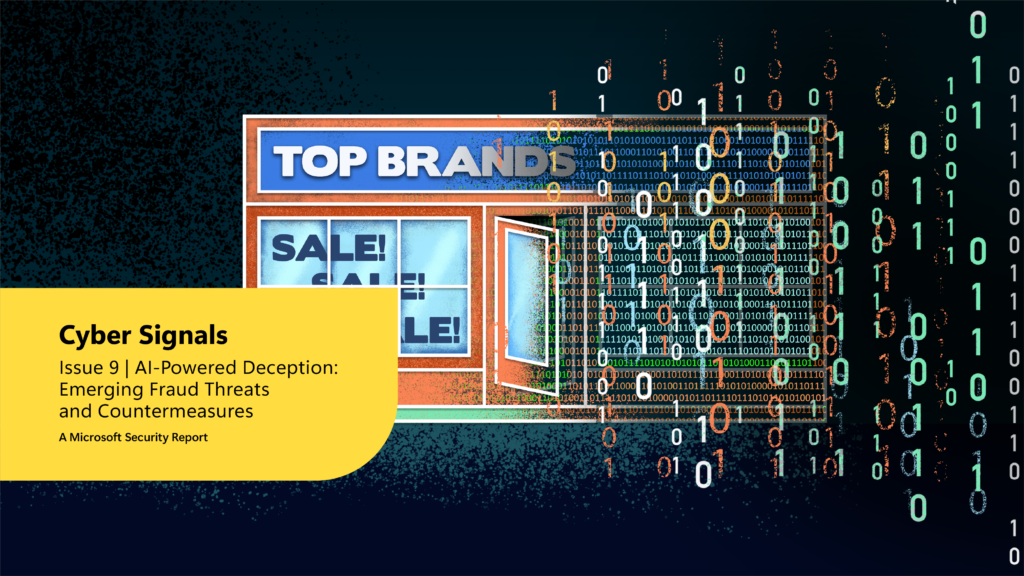Cyber Signals Edition 9: AI-Driven Deception – New Fraud Threats and Counterstrategies

Understanding Microsoft’s Ongoing Cybersecurity Efforts
Microsoft is dedicated to defending its platforms and customers from fraud and cyber threats. This commitment is evident through initiatives designed to combat fraudulent activities, such as blocking imposters on Microsoft Azure and creating anti-scam features in Microsoft Edge. These efforts reflect significant achievements aimed at protecting users from various forms of cybercriminal activity.
Security Snapshot
Between April 2024 and April 2025, Microsoft accomplished the following impressive feats in its fight against cybercrime:
- Thwarted approximately $4 billion in fraudulent activities.
- Rejected nearly 49,000 fraudulent partnership enrollments.
- Blocked around 1.6 million bot attempts to sign up every hour.
The Rise of AI-Enhanced Cyber Scams
How AI is Changing the Cybercrime Landscape
Artificial Intelligence (AI) has made it easier for cybercriminals to conduct fraud. With the help of AI software, scammers can quickly create convincing content for their attacks. These tools can scrape the web for company-specific information to craft detailed profiles of victims, making their scams more believable.
Cybercriminals use a range of AI techniques, including:
- Deepfakes: Creating realistic fake videos or audio recordings.
- Voice Cloning: Mimicking someone’s voice to deceive victims.
- AI-Generated Websites: Building believable online stores that look legitimate.
E-commerce Fraud
Fraudulent e-commerce sites can now be created almost instantaneously thanks to AI. This innovation lowers the technological barrier that previously deterred some fraudsters. These fake websites can mimic legitimate businesses, which confuses consumers. Fraudsters use AI to generate product descriptions, images, and customer reviews, further convincing customers of their authenticity.
AI-driven chatbots can also engage with consumers, lending a professional touch to these scam sites while delaying any chargebacks or complaints.
To combat these frauds, Microsoft Defender for Cloud offers extensive protection for its Azure resources. Additionally, Microsoft Edge employs features like typo protection and machine learning-based systems to detect phishing and scam sites.
Job and Employment Fraud
With advancements in AI, job scams have also become more common. Scammers create fake job postings and profiles, often using stolen credentials. They send out email campaigns designed to look legitimate, tricking job seekers into applying for nonexistent roles.
Platforms hosting job listings should consider implementing multifactor authentication and fraud detection tools to help stop these scams.
Tech Support Scams
Tech support scams trick victims into paying for services they do not need. Scammers often pose as legitimate tech support, gaining access to the victim’s device under false pretenses. Tools like Quick Assist are being misused for these purposes.
To reduce this risk, Microsoft is implementing measures within Quick Assist to alert users about potential scams, as well as actively suspending accounts that engage in unauthorized behavior.
Recommendations
For Employers
Strengthen Authentication: Use multifactor authentication for employer accounts to reduce unauthorized access.
- Monitor Recruitment Platforms: Employ algorithms to detect AI-generated content, specifically in job interviews and postings.
For Consumers
Verify Job Listings: Always check the legitimacy of jobs by looking up company details on reliable platforms like LinkedIn or Glassdoor.
- Be Cautious with Personal Information: Never share sensitive information with unverified sources or offer payment to secure job opportunities.
General Safety Tips
Avoid Impulse Decisions: Scammers often create urgency with limited-time offers. Always take time to think before purchasing.
Confirm Authenticity of Reviews: AI can generate fake testimonials; verify their legitimacy before trusting them.
- Safeguard Payment Information: Be wary of unconventional payment methods, especially those that lack fraud protection.
Leveraging Microsoft’s Tools Against Fraud
Microsoft continuously enhances its strategies to combat fraud and cyber threats. Through machine learning, they analyze patterns and improve their detection capabilities, helping to safeguard users against scams. Microsoft Defender SmartScreen and other tools provide real-time protection by identifying malicious sites and suspicious activities.
By actively collaborating with law enforcement and other organizations, Microsoft aims to disrupt the operations of cybercriminals. With ongoing education about the risks and proper responses to cyber threats, users can better protect themselves in an increasingly complex digital environment.
Kelly Bissell: A Leader in Cybersecurity
Kelly Bissell, Corporate Vice President of Anti-Fraud and Product Abuse at Microsoft, has had a significant impact on cybersecurity. His focus on using AI to enhance fraud detection showcases the potential of technology in combating cybercrime. Bissell believes that shared knowledge and collaboration among tech companies are vital for effective defense against cyber threats.
These initiatives reflect not only Microsoft’s commitment to fraud prevention but also their proactive approach in building a safer digital landscape for all users.





